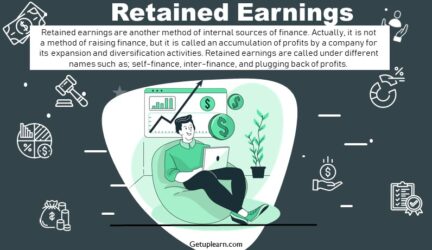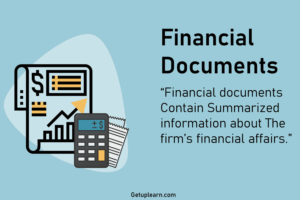The capital structure is how a firm finances its overall operations and growth by using different sources of funds. It refers to how much of each type of funds a company holds as a percentage of its total financing.
In other words, Capital Structure is referred to as the ratio of different kinds of securities raised by a firm as long-term finance. Therefore, it is a mix of a company’s long-term debt, specific short-term debt, common equity, and preferred equity.
When people refer to capital structure they are mostly referring to a firm’s debt-to-equity ratio, which provides insight into how risky a company is. Usually, a company more heavily financed by debt poses a greater risk, as this firm is relatively highly levered.
Table of Contents
Features of Capital Structure
While developing a capital structure the finance manager should aim at maximizing the long-term market price of equity shares. An appropriate capital structure should have the following features. The relative importance of each of these feature differ from company to company and may change with changing conditions.
The features of capital structure are explained below:
Returns
The capital structure should be such that it gives maximum return to the shareholders. Maximum use of leverage at minimum cost should be made so as to obtain maximum advantage of trading on equity at minimum cost.
Solvency
The company should not use excessive debt in the capital structure, because in times of higher interest rates, it can even threaten the solvency of the company.
Flexibility
The capital structure should be flexible enough that the company can alter the debt-equity ratio whenever there is a need to alter it. For example, banks do not give loans to companies if the debt-equity ratio is high, in that case, it is important to have a flexible capital structure.
Goal Oriented
The capital structure should be in congruence with the goals of the company, which implies that if the policy is that company will not take more debt, then capital structure should be framed accordingly with more equity and less debt.
Theories of Capital Structure
There are four basic theories of capital structure:
Net Income Approach
Net Income theory was introduced by David Durand. According to this approach, there is a relationship between the capital structure and the value of the firm. The firm, by increasing the debt proportion in the capital structure can increase its market value or lower the overall cost of capital (WACC).
Debt is a cheap source of finance because its interest is deductible from net profit before taxes. After the deduction of interest, the company has to pay less tax and thus it will decrease the overall cost of capital or the weighted average cost of capital (WACC).
High debt content in the debt-equity mix is called financial leverage. Increasing financial leverage will help in maximizing the firm’s value. For example, if the debt: equity mix is increased from 50:50 to 80:20, it will increase the market value of the firm and its positive effect on the value per share.
Net Operating Income Approach
According to this approach, the market value of the firm is not affected by the capital structure changes. This theory, contrary to the NI theory, does not accept the idea of increasing financial leverage.
It means a change in the capital structure does not affect the overall cost of capital and the market value of the firm. Thus at each and every level of capital structure, the market value of the firm will be the same.
The market value of the firm V = (D+E) = EBIT/Ko
V= Value of firm
(D+E)= Debt + Equity
KO = Overall cost of capital
EBIT = Earnings before interest and tax.
The overall capitalization rate (ko) depends on the business risk of the firm and is independent of the financial mix. Therefore, the market value of the firm will be constant and independent of capital structure changes. Thus, according to Net Operating Income (NOI) Approach, any capital structure will be optimum.
Traditional Approach
Traditional Theory is an intermediate approach between the net income and net operating income theories. This gives the right combination of debt and equity and always leads to enhanced market value for the firm. It states that a firm’s value increases to a certain level of debt capital, after which it tends to remain constant and eventually begins to decrease.
The traditional theory assumes changes in the cost of equity (ke) at different levels of debt-equity rate and beyond a particular point of debt-equity mix, ke rises at an increasing rate, thus reducing the value of the firm.
The effect of change in capital structure on the overall cost of capital can be divided into three stages as follows:
-
Stage I: Introduction of Debt: Increasing Value: The overall cost of capital falls and the value of the firm increases with the increase in leverage. This leverage has a beneficial effect as debts are less expensive. The cost of equity remains constant or increases negligibly. The proportion of risk is less in such a firm.
-
Stage II: Further Application of Debt: Optimum Value: A stage is reached when the increase in leverage has no effect on the value of the firm or the cost of capital. Neither the cost of capital falls nor the value of the firm rises. This is because the increase in the cost of equity due to the assessed financial risk offsets the advantage of low-cost debt. The stage wherein the value of the firm is maximum and the cost of capital is minimum Optimum Capital Structure
- Stage III: Further Application of Debt: Declining Value: Beyond a definite limit of leverage the cost of capital increases with leverage and the value of the firm decreases with leverage. This is because with the increase in debts, investors begin to realize the degree of financial risk and hence they desire to earn a higher rate of return on equity shares. As a result, the value of the firm reduces.
Modigliani Miller Approach
Modigliani Millar approach, popularly known as the MM approach is similar to the Net operating income approach. The MM approach favors the Net operating income approach and agrees with the fact that the cost of capital is independent of the degree of leverage and at any mix of debt-equity proportions.
Modigliani and Miller argued that, in the absence of taxes the cost of capital and the value of the firm are not affected by the changes in capital structure.
FAQs About the Theories of Capital Structure
What are the theories of capital structure?
The following are the theories of capital structure:
1. Net Income Approach
2. Net Operating Income Approach
3. Traditional Approach
4. Modigliani Miller Approach.
What are the features of capital structure?
These are the features of capital structure:
1. Returns
2. Solvency
3. Flexibility
4. Goal Oriented.






